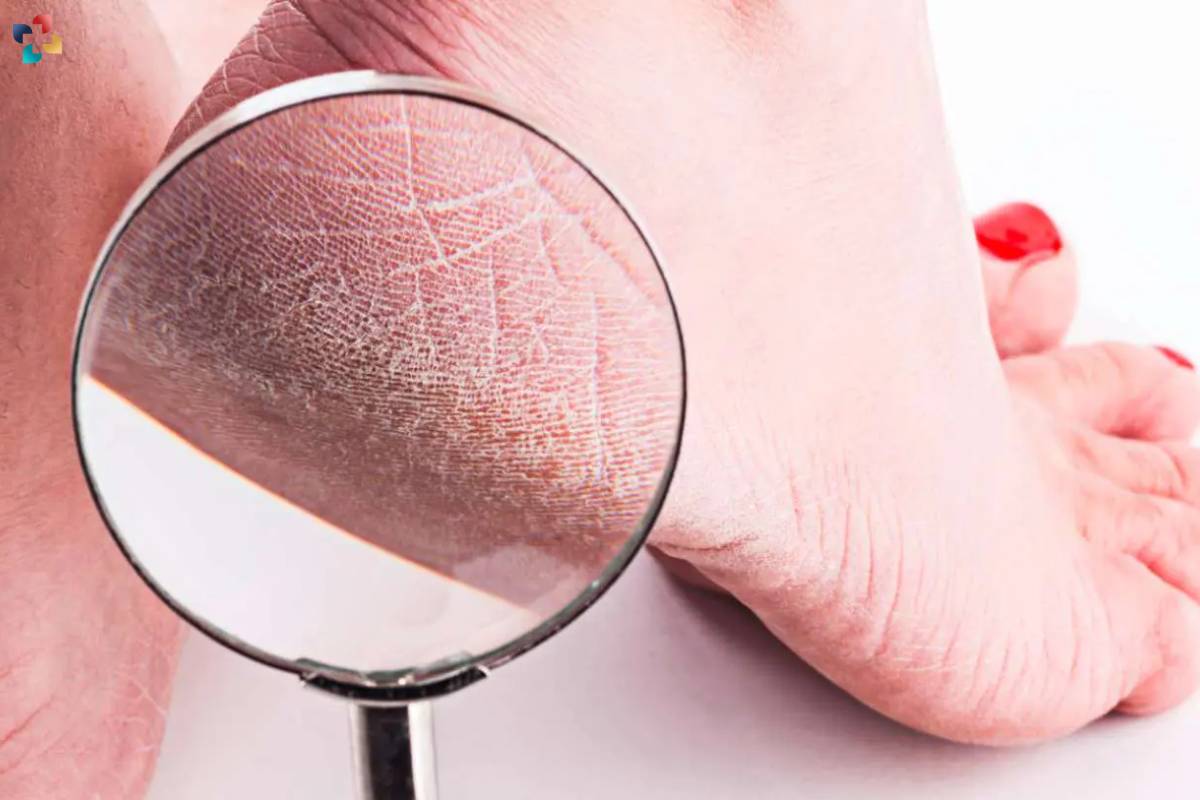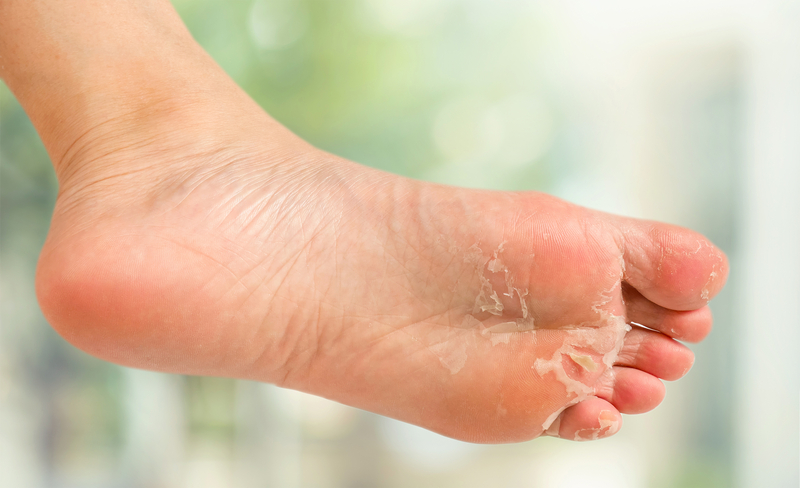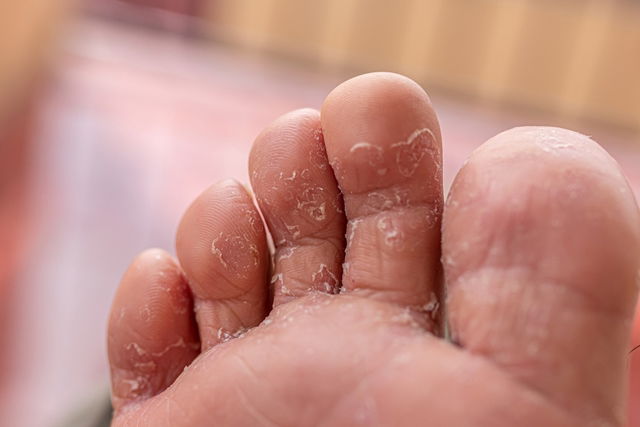Peeling skin on the feet is a common dermatological issue that affects people of all ages. It may result from a variety of causes ranging from environmental factors and skin conditions to infections and improper foot care. In some cases, the peeling may be part of a natural exfoliation process, while in others, it could signal a more serious underlying concern that requires medical attention.
This comprehensive guide explores the causes of foot peeling, effective treatments, and ways to prevent skin issues, using medically verified information from sources such as the American Academy of Dermatology (AAD), Mayo Clinic, and National Institutes of Health (NIH).
Common Causes of Foot Skin Peeling
1. Athlete’s Foot (Tinea Pedis)
One of the most frequent causes of skin peeling on the feet is athlete’s foot, a fungal infection that thrives in warm, moist environments. It typically begins between the toes and can spread across the sole and heel.
Symptoms include:
- Red, itchy, or burning skin
- Flaking or peeling skin
- Foul odor
- Blisters or cracks
Athlete’s foot is highly contagious and can spread through shared surfaces like locker rooms or showers. According to the Centers for Disease Control and Prevention (CDC), proper hygiene and antifungal treatments are key to managing this condition.
:max_bytes(150000):strip_icc()/GettyImages-1144871017-5ca3ba6ab88f4b2780eb63b0843b5f57.jpg)
2. Dry Skin (Xerosis)
Excessively dry skin can lead to cracking and peeling, especially in cooler climates or during winter. Inadequate hydration and lack of moisturizing can exacerbate the problem.
Risk factors include:
- Low humidity
- Frequent hot showers
- Harsh soaps or detergents
Moisturizers containing urea or lactic acid can be effective in restoring hydration to the skin, as recommended by the AAD.
3. Exfoliation Treatments or Peeling Masks
Some individuals use chemical foot peels containing ingredients like alpha-hydroxy acids (AHAs) or fruit acids to remove dead skin. These products intentionally cause the outer layer of skin to shed, resulting in temporary but often dramatic peeling.
While generally safe when used as directed, improper use may cause:
- Irritation
- Excessive peeling
- Sensitivity
Always follow product instructions and consult a dermatologist if unsure about suitability.
4. Hyperhidrosis (Excessive Sweating)
Chronic foot sweating can soften the skin and make it prone to peeling or infection. Hyperhidrosis affects about 3% of the population and can be managed through prescription-strength antiperspirants, iontophoresis, or botulinum toxin therapy, per the International Hyperhidrosis Society.

5. Eczema and Psoriasis
Chronic inflammatory skin conditions such as eczema (atopic dermatitis) and psoriasis can cause scaling and peeling on the feet. These conditions often require specialized treatment with topical corticosteroids, moisturizers, and lifestyle modifications.
6. Contact Dermatitis
Irritation from allergens or harsh chemicals—like certain detergents, soaps, or footwear materials—can trigger an immune response resulting in contact dermatitis, leading to redness, itching, and peeling.
7. Kawasaki Disease and Other Systemic Conditions
In rare cases, peeling skin on the feet may be a symptom of a systemic illness such as Kawasaki disease (in children), hand-foot-and-mouth disease, or nutrient deficiencies (e.g., vitamin B3 or zinc).

Diagnosis: When to See a Doctor
Peeling feet are not always a cause for concern, but you should consult a healthcare provider if:
- The peeling persists for more than two weeks
- There’s pain, swelling, or open wounds
- Symptoms worsen despite over-the-counter treatments
- You have a weakened immune system or diabetes
A doctor may perform a skin scraping, fungal culture, or allergy testing to determine the root cause.

Treatment Options
1. Antifungal Creams
For fungal infections like athlete’s foot, over-the-counter (OTC) or prescription antifungal treatments such as clotrimazole, terbinafine, or miconazole are effective.
2. Moisturizers and Emollients
Daily moisturizing can combat dryness. Look for creams with:
- Urea
- Lactic acid
- Glycerin
- Ceramides
3. Medicated Foot Peels (Use With Caution)
If using exfoliation treatments for cosmetic purposes, choose reputable brands approved by dermatologists. Avoid using them on broken or infected skin.
4. Prescription Treatments
Skin conditions like eczema and psoriasis may require:
- Topical steroids
- Calcineurin inhibitors
- Phototherapy
5. Good Hygiene Practices
- Wash feet daily and dry thoroughly (especially between toes)
- Change socks regularly
- Avoid sharing towels, shoes, or foot gear
- Use breathable footwear

Prevention Tips
To avoid foot peeling and maintain healthy skin:
- Keep feet moisturized using thick creams or balms, especially after bathing
- Wear socks made from moisture-wicking materials like wool or synthetic blends
- Avoid walking barefoot in communal areas like gyms, pools, or locker rooms
- Choose properly fitted shoes to reduce friction and sweating
- Use talcum powder or antifungal powder in shoes and socks if prone to sweating
Debunking Myths and Misleading Content
Viral images or videos showing exaggerated peeling (like the one referenced) may sensationalize cosmetic treatments or medical conditions. While they draw attention, they often lack medical context or safety disclaimers.
According to Dr. Susan Taylor, a board-certified dermatologist and spokesperson for the AAD:
“Foot peeling can be normal during certain exfoliation processes, but dramatic or painful peeling should be evaluated by a healthcare provider.”
Relying on licensed professionals and trusted health organizations ensures that you receive accurate, safe, and personalized information about skin care.

Conclusion
Peeling skin on the feet can be caused by a range of conditions—from mild dryness to fungal infections or chronic skin disorders. Knowing the root cause is key to finding the right treatment. Practicing good foot hygiene, moisturizing regularly, and consulting a dermatologist for persistent symptoms will help keep your feet healthy and comfortable.
If you’re experiencing unusual skin changes, don’t rely on viral images or unverified remedies. Seek medical advice to ensure your skin is treated effectively and safely.
Reputable Medical Sources Cited
- American Academy of Dermatology (AAD)
- Mayo Clinic – Athlete’s Foot
- Centers for Disease Control and Prevention (CDC)
- National Institutes of Health (NIH)
- International Hyperhidrosis Society
